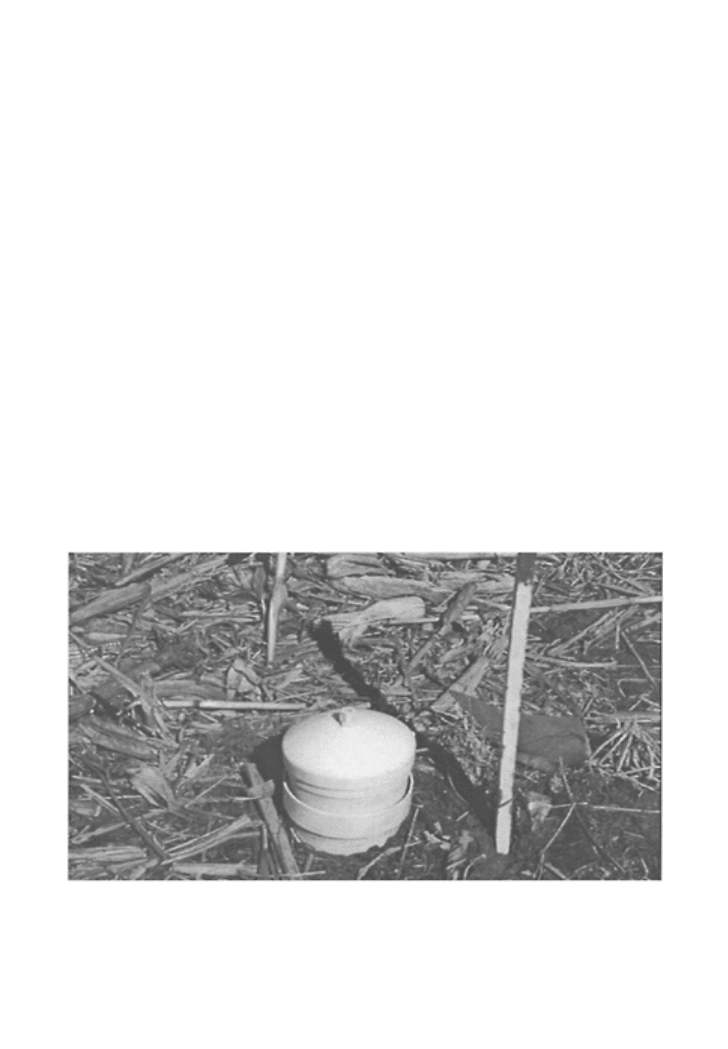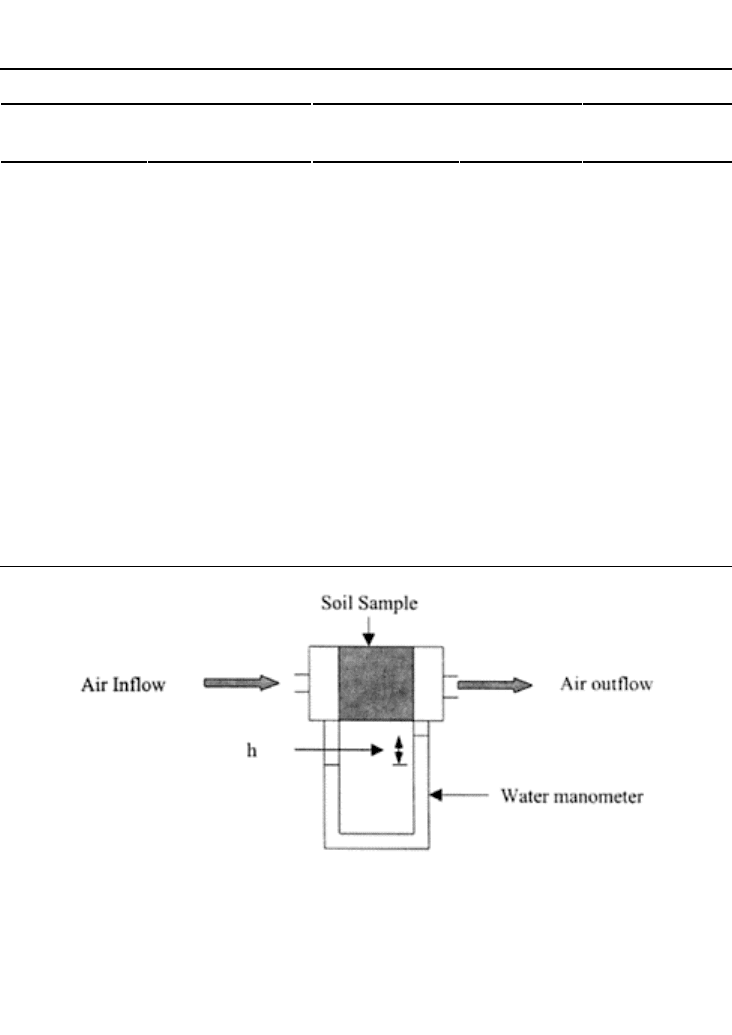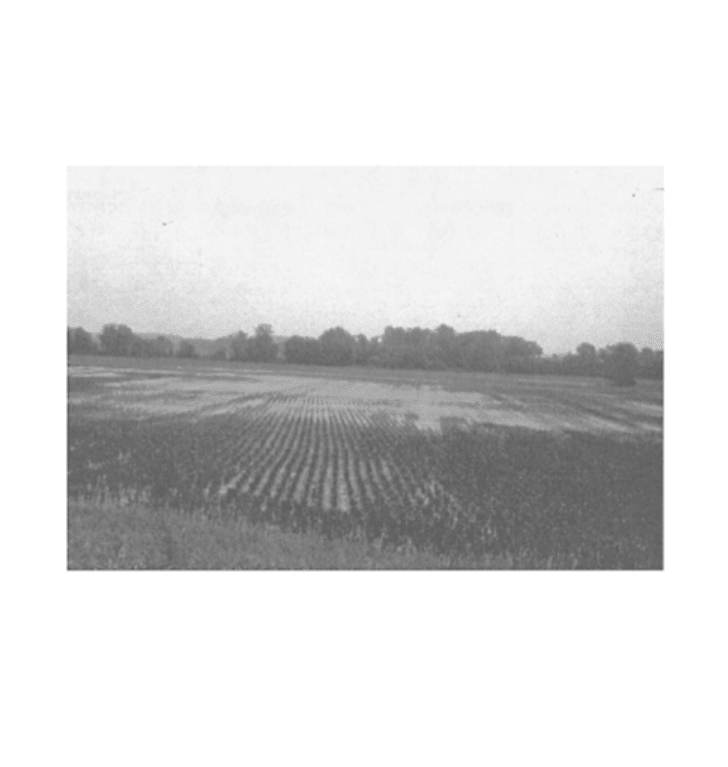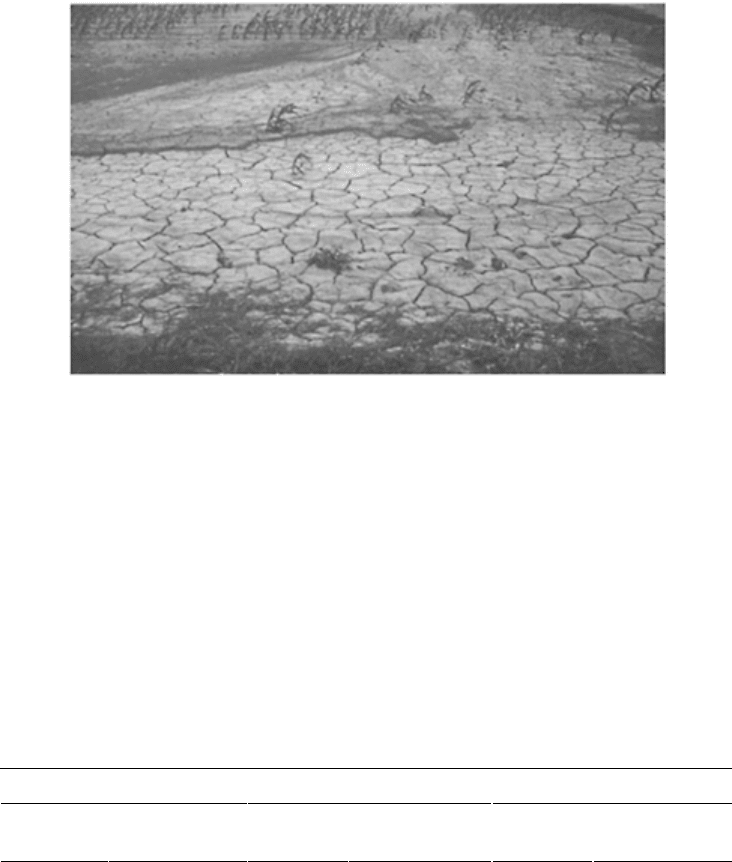Lal R., Shukla M.K. Principles of Soil Physics
Подождите немного. Документ загружается.


diffusion tube is used under field
conditions. Soil air sample is taken
from the tube using a syringe.
The other traditional method involves the determination of the composition of soil air
(Fig. 18.2). This method, although again static, is better than the measurement of air
volume alone. The depletion of O
2
content in soil air can be a good indicator of the
restricted gas exchange in the soil matrix and between soil and the atmosphere (Fig.
18.3). Still, the main concern here is how to extract a sample that is large enough to
provide a measurement but at the same time small enough to represent the sample point
and to avoid disturbances and mixing of soil air or contamination from the atmosphere.
The gas chromatography technique can provide reliable measurements. An alternative
method, which permits repeated measurements of oxygen concentrations in soil air
without extracting a sample, is based on the use of membrane-covered electrodes
(McIntyre and Philip, 1964).
Soil aeration can be characterized by the oxygen diffusion rate in the soil or ODR,
(Erickson and van Doren, 1960). The method is based on the hypothesis that the moisture
films around plants roots and organism limit the rate of O
2
diffusion. The ODR can be
measured by a platinum electrometer under a constant electric potential (Lemon and
Erickson, 1955). Once the O
2
present near electrode surface is depleted further depletion
is a function of O
2
diffusion to electrode surface or current. The electric current (I, A) is
proportional to the rate of O
2
flux at the electrode
FIGURE 18.3 A static chamber is
used under field conditions to assess
the gaseous emission over a short
period of 10 to 15 minutes. (Waterman
Farm, Columbus, OH, 1998.)
Principles of soil physics 534

surface and can be expressed as follows:
(18.36)
where ODR is oxygen diffusion rate (g m
−2
s
−1
), M is the molar mass of oxygen (32g
mol
−1
), F is the Faraday’s constant (96,500 coulombs equiv.
−1
mol
−1
), A is the electrode
surface area (m
2
), and n is equal to four (equiv. mol
−1
) and is the number of electrons
required to reduce one molecule of O
2
. The ODR values in soils vary from 0 to 200 µg
m
−2
s
−1
and increase with suction and air-filled porosity of soil (Glinski and Stepniewski,
1985). The ODR method is satisfactory in soils having higher aeration and is less
effective for poorly drained or flooded soils. The methods of soil aeration measurement
are listed in Table 18.13. Another approach of characterizing soil aeration is to measure
the air permeability.
18.12 AIR PERMEABILITY
The gaseous exchange between soil and the atmosphere and the transport of gases within
the soil are complex phenomena. Characterizing soil aeration by measuring content and
composition of soil air are inadequate because they do not take into account the process
dynamics, directions, and rate of change. Air permeability of soils has been recognized as
an important
TABLE 18.13 Methods of Measurement of Soil
Aeration
Method Reference
Air pycnometer Page (1948), Vomocil (1965)
Membrane covered electrodes McIntyre and Philip (1964)
Gas chromatography Bremner and Blackmer (1982)
Closed chamber Matthias et al. (1980)
Flow through chamber Denmead (1979)
parameter for soil aeration and contaminant remediation techniques and is fundamental to
our understanding of environmental problems in the vadose zone. The vadose zone
comprises the region between the land surface and underlying groundwater aquifers
varying in depth and composition. It is the geologic zone through which water, solutes,
nutrients, and/or contaminants travel prior to reaching groundwater. In agricultural
research, knowledge of air-filled pores, pore size distribution, tortuosity, air permeability,
and their variation along the cross section or depth is important to describe aeration,
structure, and compaction of the soil. Precise impact of these parameters on crop yield is
not known. In general, poor structure, low air-filled porosity, and water permeability
adversely affect crop yield (Moore and Attenborough, 1992).
Soil air and aeration 535

Air permeability of porous media, including soils, is governed by the convective
transport of air through the media under a pressure gradient. The gaseous flow as a
consequence of the pressure head difference is often reported as the mass flow of gas.
The other mechanism of gas transport is the diffusion, which occurs due to the change in
concentration gradients or the partial pressures of the components of the gaseous mix. If
the concentration and pressure gradients exist concurrently, both these processes can
occur simultaneously. The mass flow of gas is important when differences in pressure are
due to the change in barometric pressure, temperature, or soil water content. However,
diffusion is considered the primary mechanism.
In general, a soil matrix consists of a mixture of fluid and gaseous phases. Since
viscosity of air is small compared to that of water, soil air remains at most phases in the
soil matrix at or near atmospheric pressure. A small pressure gradient is sufficient for soil
air to move into or out of the soil system. As a result it has a negligible effect on flow of
water and therefore most water transport analysis ignores the simultaneous movement of
soil air. The negligible influence due to the low-pressure gradients in soil air is generally,
but not necessarily always, true. In case of border irrigation, effects of air compression
ahead of the wetting front during infiltration of water into the soil can occur (Dixon and
Linden, 1972; Morel-Seytoux and Khanji, 1974). During drainage, air entry through the
restrictions within the soil pore space causes surge of water in the draining soil columns
(Corey and Brooks, 1975). Airflow through soils is essentially nondestructive and air
permeability is sensitive to the changes in soil structure (Corey, 1986). Air permeability
can be used as a soil quality indicator to characterize the changes in soil structure
resulting from different soil management practices (Ball et al., 1988).
Air permeability is a function of pore characteristic and several soil hydrological
properties, which are often more difficult to measure. Air permeability at −100 cm soil
suction is a potential indicator for providing information about changes and differences of
soil structure (Kirkham et al., 1958). Air permeability is related to air-filled
macroporosity at different water contents to identify the changes in soil structure and soil
water dynamics by soil management practices and biological activities (Blackwell et al.,
1990), which are useful for studying the remediation of contaminated soils by modeling
the soil-vapor extraction system (Moldrup et al., 1998). Tortuosity expresses a structural
condition of soil and can be used as an index of soil structure (Moldrup et al., 2001). Soil
structure has a strong influence on air permeability, and convective transport of air takes
place through the larger pore networks in well-structured soils. The flow pattern in well-
structured soils can be different for the air and water flow because of the differences in
geometries and tortuosities of the two mediums. The saturated hydraulic conductivity is
strongly correlated to air permeability at −100 cm of suction (Loll et al., 1999). The
relationship between air permeability and saturated hydraulic conductivity in undisturbed
soil media can be developed using pore scale network models (Fisher and Celia, 1999).
18.12.1 Governing Principles
According to Darcy’s law for laminar flow, velocity of a given fluid is proportional to the
pressure difference and inversely proportional to the length of flow path (Kirkham,
1946). Therefore, Darcy’s law is applicable for the airflow through soils. The pore sizes
and macropores or cracks greatly contribute to airflow in a soil. According to Poiseuille’s
Principles of soil physics 536

equation, air flow through a single pore varies as the fourth power of the pore radius
(Q
a
αr
4
) According to Darcy’s law, air permeability (k
a
) can be defined by the following
relationship:
(18.37)
where q
a
is the volume flux per unit area (L
3
L
−2
T
−1
); ηa is the dynamic viscosity of air
(ML
−1
T
−1
); p is the pressure of air (ML
−1
T
−2
); and x is the distance in direction of flow
(L). Air permeability of soil samples is calculated by modifying Eq. (18.37) as follows:
(18.38)
where Q
a
is the volumetric flow rate (cm
3
s
−1
), ∆H
a
is difference in pressure head (cm), ρ
a
is density of air (gcm
−3
), g is acceleration due to gravity (cm s
−2
), A is the cross-sectional
area (cm
2
) and L is the length of the sample (cm). Note the dimensions of air permeability
coefficient, k
a
as L
2
, which are similar to the intrinsic permeability of soil and therefore k
a
is also referred to as intrinsic permeability of air (Reeve, 1953). The cross-sectional area
and the length of soil sample are replaced by a shape factor to measure in situ air
permeability.
18.12.2 Air Permeability Measurement Methods
Wyckoff and Botson made air permeability measurements as early as 1936 by forcing a
mixture of water and air through long tubes of unconsolidated sands. The experiments
were repeated with different flow velocities and water and air permeability were
measured simultaneously. The air permeability methods can be broadly divided into
steady state and unsteady state methods. The steady state methods are based on
establishing a steady airflow rate at the inlet through the soil sample and measuring the
flow rate and pressure head difference across the sample. The transient methods are
generally quicker, easy to use, and require less volume of air for the experiment (Smith et
al., 1998). Another approach to air permeability measurement is known as the acoustic
technique. The following sections describe these methods in more detail, and the merits
and demerits of each method are presented in Table 18.14.
Steady State Methods
Steady state methods can also be described as constant pressure gradient methods or
constant flux methods (Grover, 1955). In this method, air is pressed across a core sample
at a constant pressure above the atmospheric pressure (Fig. 18.4). The flow rate of air at
the inlet end of the core is measured over a given time interval. The constant pressure
gradient method is suitable for highly permeable samples and those at higher water
content.
Soil air and aeration 537

TABLE 18.14 Merits and Demerits of Air
Permeability Measurement Methods
Steady state laboratory method Transient method Acoustic method
Pressure
gradient
Flux method Core method Field method Field method
Constant pressure
gradient
Constant flux Drop in pressure
in air tank
Drop in
pressure in air
tank
Reflection and
transmission of
audio frequency
Easy and simple Constant flux and
gradients are
difficult to attain
Rapid and easy Practical, rapid
economical
and easy
Rapid but requires
skilled labor
Suitable for highly
permeable soils
Suitable for less
permeable soil
Suitable for both Suitable for
both
Suitable for
homogeneous soils
Does not alter
water content
Water content is
altered
Does not alter
water content
Does not alter
water content
Does not alter
water content
Disadvantage of
air flow between
soil and core
Disadvantage of air
flow between soil
and core Soil
shrinkage
Disadvantage of
air flow between
soil and core
— —
Well developed Well developed Well developed Well
developed
Under
development
FIGURE 18.4 Schematic of the
apparatus of measure air permeability
(k
a
).
Because the air pressure gradient is small for these soils, the measurements can be made
easily without altering the water content or liquid phase of the samples significantly. The
Principles of soil physics 538

air permeability of soil using a constant pressure gradient method for air pressure less
than 0.2 m of water can be calculated by Eq. (18.38).
The pressure difference across the core sample can be measured for an applied
constant air flux at one end of the column (Blackwell et al., 1990). This method is
relatively simple and requires a gas cylinder with a flow meter. The core sample can be
placed inside a chamber and is connected to a water manometer for measuring the
pressure difference across the sample, and the pressure gradient may be as high as 0.2 m
of water. The air permeability can be calculated by the constant flux method as follows
(Kirkham, 1946):
(18.39)
If
the term in parentheses approaches unity and Eq. (18.39) reduces to
Eq. (18.38). The constant flux method is simple and straightfor-ward and is useful for
soils of low permeability. However, it has two basic disadvantages: (i) the dry air changes
the water content of core sample, and thus the air permeability and (ii) the constant air
flux and gradient are difficult to achieve.
The conservation of moisture in the core sample is an important requirement for air
permeability measurement. The water content of the core sample is a function of the
pressure difference between both air and water; the pressure gradient between these two
competing fluids should be equal in magnitude and direction. One of the methods is the
stationary liquid method (Brooks and Corey, 1964), in which air flows upward and
through the sample in response to a pressure gradient equal to that in a static liquid. The
method was originally developed for measuring the air permeability of porous rocks. The
details of this method are given by Corey (1986).
Another method uses both fluids flowing with equal pressure gradient in any direction.
Ceramic porous plates are kept both at the inlet and outlet end of the system for
controlling the inflow and outflow of water through the sample. The soil water pressure
and piezometric head difference is measured directly by a pressure transducer connected
with piezometer rings. The procedure allows the water to keep on flowing while
permeability measurements are made. The inflow and outflow can be adjusted to obtain a
steady state flow condition. A more accurate assessment can be made by simultaneously
measuring the change of water content during permeability measurement mounting the
soil sample on a scale and calculating the change in water content of soil sample by
change in weight (Brooks and Corey, 1966). The merits and demerits of this method are
presented in Table 18.14.
Transient Methods
Transient methods are more practical, quicker, less expensive, and easier to use (Table
18.14). They can be employed for air permeability measurements both in a lab on soil
cores and in situ in the fields. They also require less volume of air to pass through the soil
core or soil volume for a given permeability determination. The duration of the tests is
shorter and soil desaturation or drying is less as compared to a steady state method.
Kirkham (1946) first proposed the transient method as an in situ field method. In the
Soil air and aeration 539

transient method one end of a soil core is connected to a close pressurized air tank and
the other end is kept open (Fig. 18.5). The rate of drop of air pressure in the tank is
measured as air flows out through the other end and is used to calculate the air
permeability of soil (Kirkham,
FIGURE 18.5 Schematic of an air
permeability apparatus on soil cores
for a transient method.
FIGURE 18.6 Schematic of an in situ
air permeability apparatus for a
transient method.
1946; Smith and Mullins, 1991; Stephens, 1996; Smith et al., 1997; Smith et al., 1998).
Schematics of an in situ permeameter are given in Fig. 18.6 (Kirkham, 1946; Grover,
1955). Iversen et al. (2000) further modified the in situ air permeameter and replaced the
float by a gas cylinder and a water manometer. Their apparatus is suitable for soil
permeability measurements in situ, on site and in the laboratory on soil cores.
Principles of soil physics 540

The in situ methods of air permeability measurements are preferred over the lab
methods and have the advantage of assessing scale effects on permeability and anisotropy
(Garbesi et al., 1996). However, these methods involve insertion of steel or plexiglass
containers in the ground. Some of the disadvantages of these methods are the unknown
sample length, disturbance of natural soil condition, and lack of or low reproducibility.
Traditionally, air permeability calculations are made for isothermal conditions. Smith et
al. (1997) showed that the traditional isothermal method is inaccurate because the
pressure in the air tank cools the air inside. As a result, rate of change of air pressure in
the tank does not represent the true mass flux out of the air tank and through the soil
sample. Smith and colleagues proposed mathematical expressions for compensating the
temperature effects for known temperature changes in the soil tank.
Acoustic Methods
Sound reflected from a soil surface interferes with the incident sound and causes an
interference pattern in the total sound field. If the acoustic properties of porous media are
known, interference patterns can be modeled from theory of sound propagation.
Attenborough (1985) presented analytic approximations for calculating the sound levels
from outdoor sound sources on or near the ground in terms of acoustic properties of soil.
For a homogeneous porous media these acoustic properties depend on the air filled
porosity of soil surface (Attenborough, 1987). The acoustic techniques involve the
measurement of both the reflection and transmission of audio frequency and sound by the
soil. Sound reflection measurements give qualitative indications of relative air
permeability. Inserting a probe microphone at a given depth and keeping another
vertically separated above ground makes sound transmission measurements. The
theoretical predictions for homogeneous soils are fitted to the measured reflection and
quantitative information on surface air filled porosity, and air permeability is obtained.
The acoustic techniques have been validated on a series of trial plots, for a variety of soils
and have been found within 10% of those obtained conventionally (Sabatier et al., 1990,
Moore and Attenborough, 1992). They have shown a potential for the measurement and
monitor-ing of management induced or seasonal changes in soil surface properties (Table
18.14).
18.13 MANAGEMENT OF SOIL AERATION
Poor aeration, due to inundation or compaction, affects crop growth by seedling mortality
(Fig. 18.7) and creating poor soil physical conditions (Fig. 18.8). Therefore, management
of soil aeration is important, which can be accomplished in a number of ways (e.g.,
tillage, drainage, mulches, etc.). Tillage is usually defined as the mechanical
manipulation of soil to improve soil aeration conditions, control weeds, and incorporate
organic matter in the soil, which directly affect crop production. Tillage practices on one
hand open the soil and increase the porosity and soil aeration at least temporarily, and on
the other hand compact the soil surface, increase bulk density, and reduce aeration for the
soil below the plow layer. The use of conservation tillage and/or no-till improves the soil
physical conditions and quality (Lal, 1989). A no-till system improves organic carbon
Soil air and aeration 541

concentration in soil, which in turn improves aggregation and aeration porosity of soil.
The aeration porosity and ODR under different tillage practices are generally
significantly correlated (Flowers and Lal, 1998). The data in Table 18.15 show that
aeration from no-till treatment is much higher than moldboard or chisel treatment for 5
cm and 15 cm depths, however, corresponding ODR values are not necessarily a direct
function of soil aeration (Flowers and Lal, 1998). This apparent
FIGURE 18.7 Poorly drained sites are
inundated during spring leading to
seedling mortality, patchy stand, and
low yields. (Courtesy of Dr. N. R.
Fausey, USDA Drainage Unit,
Columbus, OH.)
Principles of soil physics 542

FIGURE 18.8 Soil structure is
adversely affected in poorly drained
soils. (Courtesy of Dr. N. R Fausey,
USDA Drainage Unit, Columbus,
OH.)
discrepancy may be due to the fact that intraaggregate ODR measure-ments are lower and
represent anoxic conditions, whereas interaggregate measurements are higher and reflect
higher aeration status between aggregates (McCoy and Cardina, 1997). The crop residue
on soil surface
TABLE 18.15 Mean Aeration Porosity (f
a
) and
ODR at 5 cm Depth from Moldboard Plow (MP),
Chisel Plow (CP), and No-Till (NT)
Moldboard plow Chisel plow No-till
AP (cm
3
cm
−3
)
ODR
(µgcm
−2
s
−1
)
fa (cm
3
cm
−3
)
ODR (µg
cm
−2
s
−1
) )
fa (cm
3
cm
−3
)
ODR
(µgcm
−2
s
−1
)
5 cm depth
0.054 12.2 0.13 12 0.185 12.5
0.06 13.8 0.145 11.8 0.195 12
0.12 22 0.19 23 0.23 17.5
15 cm depth
0.002 7.5 0.035 10 0.058 8.8
Soil air and aeration 543
